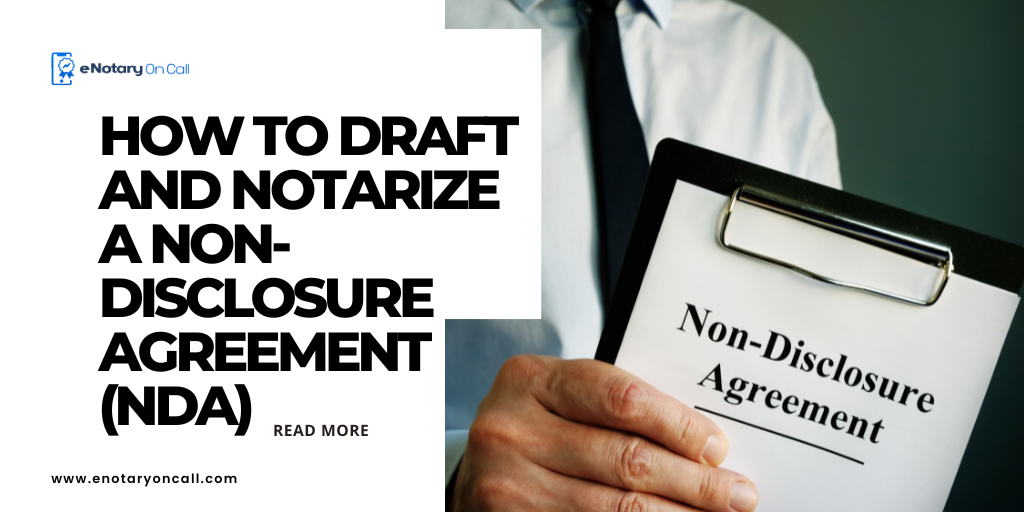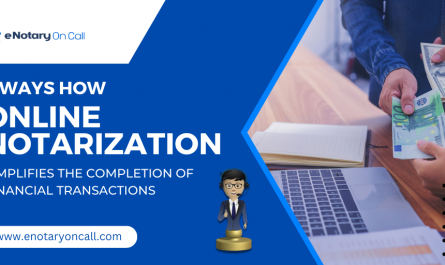We live in an era where information is shared online. And, with this, keeping it protected has become much more critical than before. Hence, whether it is a business partnership, client communication, trade transaction, or personal relationship, the introduction of a non-disclosure agreement (NDA) in between is necessary. It helps in protecting confidential information.
To make it more straightforward, the blog is published with all the whats, whys, and hows to give a clear picture. Additionally, there is a guide on how to notarize NDA documents.
What is a Non-Disclosure Agreement (NDA)?
The non-disclosure confidentiality agreement is a legally enforceable contract. It helps make relationships confidential regarding sensitive data sharing. It binds both parties not to share information, as failure to do so may result in legal action.
Usually, parties sign a non-disclosure agreement at the beginning of the contract. Thus, every essential term and condition related to service or transaction is mentioned in the NDA agreement form. For instance, when a client wants to hire a new contractor to complete a job within a specific timeline, they create a non-disclosure agreement that outlines the terms and conditions for sharing sensitive data.
It has been observed that many have questions about the importance of a non-disclosure agreement. Thus, the blog further throws light on this.
Importance of Mutual Non-Disclosure Agreement
The importance lies in its purpose. There are two main reasons: one, it ensures confidentiality among the parties; the other, it protects both parties’ data. Both are non-negotiable factors when the agreement is signed. In this way, a business model gains a legal framework for protecting ideas and sharing information. Everything that can ruin the partnership can be easily avoided with NDA forms.
Furthermore, the NDA agreement also influences parties to stick to it; otherwise, it triggers legal action, financial penalties, or lawsuits. Seemingly, the importance of an NDA can be determined by the types of penalties legally imposed, even in the event of an accidental breach.
In brief, there are a few essential functionalities related to NDA:
- Identifying information to protect: In the NDA contract, it is mandatory to specify clearly what can be shared. This sets a boundary for moving further with confidence and confidentiality.
- Protecting the information: After the identification, there is a step to create an obligation to protect the sensitive data. This prevents the breach of contract.
- Protect the patent rights: Often, disclosing an invention in a pending state can lose protection. Thus, the NDA helps protect the inventor’s rights to their new concept.
Along with understanding its importance, it is also necessary to recognize the importance of notarizing a general non-disclosure agreement.
There are many situations, such as finding new investors, hiring new employees, or entering into a new partnership, in which sensitive information is shared. The NDA becomes necessary for information safety. To share more precise information on the need for an NDA before any partnership, here are five situations where it is essential:
- First, when a product is launched or in development, to protect its technical information, proprietary rights, or financial insights while selling or licensing. A legal non-disclosure agreement is a must.
- Second situation is during the employment of a new employee. The signing of the NDA form helps keep client or company information safe. Even when they leave, your sensitive data will be protected.
- Third situation is when there is a new partnership to protect your business talks with investors.
- The fourth situation in which the NDA contract for sensitive information is essential is during new-client onboarding.
- And the fifth circumstance is during mergers or acquisitions. This keeps the financial data safe and operational information protected. Intermediaries or brokers must also protect data.
To utilize an NDA effectively, the non-disclosure agreement must be drafted correctly. There are a few key elements that should be there to make the non-disclosure agreement notarization format precise and enforceable.
Thus, take note of how it can be drafted.
Elements to Make an Enforceable NDA
There are 7 elements that should be clearly defined to ease the understanding of the document for both parties. They will have the correct information regarding the data exchange during a business partnership.
- Relevant Parties: The first and foremost information in the document will undoubtedly be the explicit mention of the parties. Their names, addresses, legal entities, and other critical personal or professional records should be put up. Accurate identity data will make both parties aware of the consequences in the event of contract breach.
- Accurate Mention of Confidential Data: Undefined or unclear references to sensitive data that cannot be shared create many loopholes. Thus, while drafting the NDA contract form, all uncompromised data should be accurately defined. This will only help take strict legal action in the event of a data breach.
- Right Information Use: In the second step, when confidential data is stated, the next factor is to use the correct language. It is necessary to protect external parties from interfering with data sharing. To explain with an example, a tech company has data that cannot be compromised in any way. The agreement form will ensure that the client does not use any product data without permission. Further, it also protects the marketing of the solution of the signing party.
- Local Time Limit: The NDA does not last a lifetime; it has a limited duration. Thus, to protect information for a specific period, it is essential to specify the timeline. This will bind both parties to partner with trust and do business to grow.
- Exclusion of Liability: The document should include language that absolves both parties of legal liability. Data that can be shared and is publicly available should be mentioned so both parties are aware of it beforehand.
- Return of Information: When the NDA notarization document is prepared, it should explicitly state the return or deletion of confidential sensitive data. Once the business is concluded, both parties must secure their information. Thus, mention precisely that when it ends, the data should be shredded.
- Remedies for Breach: If there is a breach, the NDA should clearly specify its consequences. In this way, every party doing business is aware of the penalties. It also helps with negotiation before finalizing the NDA form. This will help avoid any legal action during or after the partnership.
These factors should be clearly defined, with corresponding consequences for violations. This will ensure that there is no breach of terms, and businesses or individuals are already prepared with information to begin the partnership.
Who Can Help with the Draft?
Creating a template can be a little confusing, even after knowing about the essential elements to include. But there are available NDA templates with pre-written agreements. These can easily be edited to negotiate before the partnership begins.
Using templates has many benefits:
- Time-Saving: It will help start the partnership on time, as a bulk of NDAs notarization for legal, financial, or operational purposes will be created more quickly. It will then lead to the project’s completion within the agreed timeline.
- Cost-Saving: The availability of pre-designed non-disclosure agreement templates online will also be cost-effective. There will be no need for the general counsel to draft for long hours.
Does It Require Notarization?
Although an NDA does not require document notarization, having it notarized legally binds the parties to the terms and agreement. Eventually, it will help keep information secure by increasing credibility. The signature will add authenticity in case there is any future conflict.
How Can It Be Notarized?
There are two ways to document notarization: traditional and online notarization. Remote online notarization is recommended to save time and cost. The availability of an online notary in Florida or your city will connect the parties for both identity verification and document authorization. Many trusted platforms will guide you through 4 easy steps to obtain a notarized NDA.
Step 1: Log in to a reliable platform such as eNotary On Call.
Step 2: Upload the document(s).
Step 3: Verify identity with government-issued IDs and verify the document by connecting to a notary online.
Step 4: Get it signed and download it to produce wherever it is required.
Conclusion
A well-drafted and notarized Non-Disclosure Agreement (NDA) is the key to maintaining confidentiality and trust in any partnership. Whether it’s for a client, employee, or investor, having an NDA ensures your sensitive data stays secure and your professional relationship remains transparent. Adding NDA notarization brings authenticity and strengthens its legal value. Always make sure your NDA is properly drafted, signed, and notarized to protect your information.
Ready to secure your agreement?
Log in now to quickly, easily, and with complete confidence create, sign, and notarize NDA online.
FAQ
1. What is a Non-Disclosure Agreement?
A Non-Disclosure Agreement (NDA) is a legal contract that establishes a relationship between parties to protect sensitive information. It helps set restrictions on the disclosure of confidential data during the agreed term while conducting business transactions.
2. Do Non-Disclosure Agreements Hold Up in Court?
Yes, NDAs can be upheld in court, but their enforceability depends on several factors. Legal standards related to clarity, scope, duration, and mutual consent play a key role in determining whether an agreement is valid and enforceable.
3. What Happens If You Break a Non-Disclosure Agreement?
When an NDA is drafted, it specifies the consequences of a breach. Therefore, breaking the agreement can lead to legal actions such as a lawsuit, financial penalties, or termination of client projects.
4. Are Non-Disclosure Agreements Legal?
Yes, NDAs are legal contracts and can be legally binding. They are used to protect confidential information and are valid when created for lawful purposes. However, the terms of the agreement must not prevent any party from earning a fair livelihood.
5. How to Sign a Non-Disclosure Agreement?
Before signing, the document should be carefully reviewed. It can be signed either physically or digitally. For online signing, the document is uploaded, and the signature is completed in the presence of a notary public or witness. After signing, the document can be downloaded or stored digitally for future reference.
6. Can a Minor Sign a Non-Disclosure Agreement?
A minor can sign an NDA notarization; however, they cannot enter into a legally binding contract. To make the agreement enforceable, it is advised to include the minor’s parent or legal guardian as a co-signer




